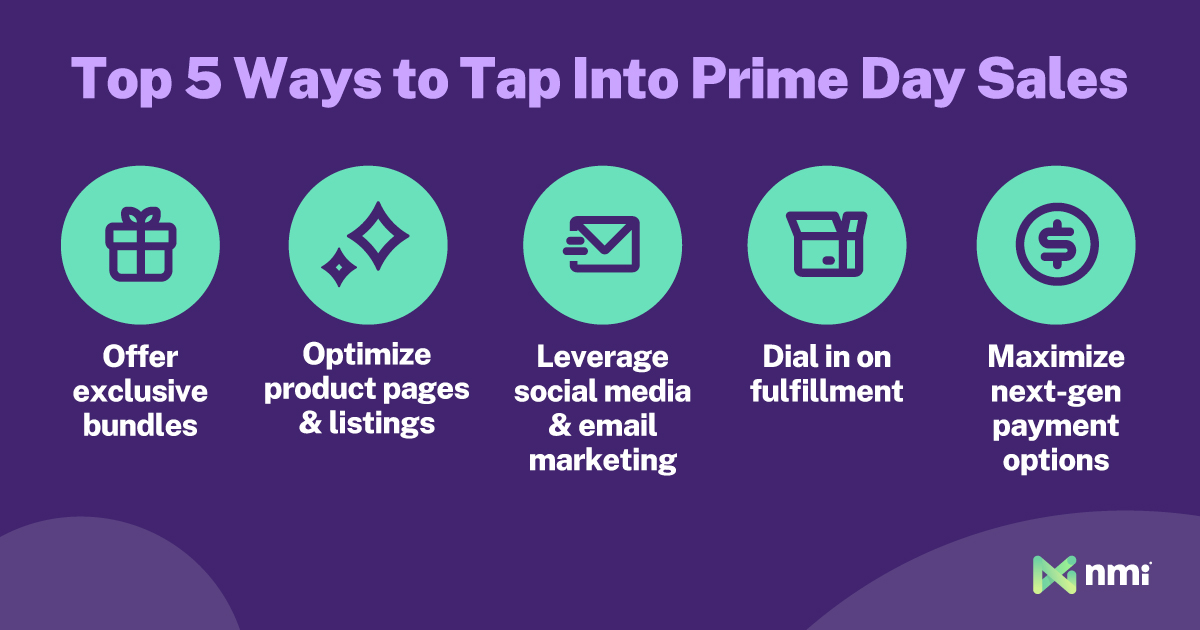Amazon Prime Day 2024 is almost here, and that means great deals for Prime members. The sales event started in 2015 as a way to reward Amazon Prime members in celebration of the company’s 20th birthday. Almost a decade later, Prime Day is an annual two-day event that generates over $12 billion for Amazon in the United States alone.
As with all good sales, competitors have taken notice, and other retailers — ranging from giants like Walmart, Best Buy and Target to small local businesses — have started offering their own sales to draw hungry consumers away from Amazon. Some big retailers will price-match Prime Day sales. Others, like Walmart, offer their own competing events.
It’s clear that Prime Day has effectively created a new summer sales holiday, and that’s good news for more than just consumers.
As a payment provider or SaaS platform offering ecommerce services, it’s important to remember that your small-, medium-sized and micro-enterprise (SMME) customers need more than just great payment solutions. With Prime Day around the corner, it’s the perfect opportunity to guide your merchants through the unique opportunities it brings. One way to do that is by sharing practical strategies to help them make the most of Prime Day and stand out from the crowd. It’s all about giving merchants the tools to thrive and succeed during this lucrative shopping event.
What Prime Day Means for Retailers and Merchants
When it started, Prime Day only benefited Amazon Prime members. Today, competitors are racing to match or beat Amazon’s sales, offering unique products and services while allowing shoppers outside of Amazon’s network to take advantage of exclusive offers. For merchants, this means two things: consumers are ready to spend and willing to shop around.
Research from Impact.com found that, in 2023, shoppers made 41% more purchases across all ecommerce brands on Prime Day, with non-Amazon retailers seeing a 52% increase in clicks over the previous year. While Prime Day may be exclusive to Amazon members, its widespread success benefits the entire space, including small brick-and-mortar retailers, who are tapping into the ecommerce frenzy while giving customers instant access to in-store inventory.
After a decade of Prime Day events, consumers expect competing deals from the brands they know and love, making the event a massive opportunity for merchants who sell on and off Amazon. With the summer being a traditionally slow retail season, the chance to generate holiday-like revenue is not something any seller should pass up.
Prime Day Shoppers Are Getting Younger
Online shopping has always skewed towards younger consumers. Millennials were traditionally the dominant demographic driving Prime Day sales. But, in 2023, Generation Z — half of whom are now adults with disposable income — stole the crown. 58% of Gen Z adults said they shopped during Prime Day sales in 2023, compared with 53% of millennials.
Younger consumers have different expectations for what a shopping experience should be like. Whether online or in-store, merchants will need to keep Millennial and Gen Z shopping preferences in mind. That includes everything from chosen sale items to the checkout and payment experience.
With 40% and 37% of Gen X and baby boomers taking advantage of Prime Day sales, there’s no question that merchants should pay close attention to younger and older shoppers during this sales event. Thankfully, as a payment provider, you’re in the perfect position to help your merchant customers reach a wider audience and create an unforgettable shopping experience.
The Top 5 Ways to Tap Into Prime Day Sales
Merchants are able to tap into Prime Day’s success by selling through Amazon’s third-party marketplace. Prime Day is consistently the best day of the year for Amazon’s independent sellers. In 2020, independents generated over $3.5 billion in sales worldwide through Prime Day on Amazon Marketplace. In 2023, some saw an 18x increase in sales on day one alone.
But what about SMB merchants that aren’t selling through Amazon Marketplace, but still want to boost revenue through their own competing sales?
Below, I’ve outlined the top five ways small sellers can compete with giants like Amazon, Target and Best Buy during Prime Day 2024. With the right strategies (and payment partners), SMBs can increase revenue and improve the overall customer experience.

1. Offer Exclusive Bundles That Boost Value
It can be hard for small sellers to match big competitors’ prices during Prime Day. However, discounted bundles are a great way to get around that. With exclusive bundles, retailers can do two things:
- Offer lower discounts on each item while providing more value as a whole
- Provide products or services that Amazon and other big retailers don’t offer
Strategically identifying highly discounted Prime Day items and then creating bundles to compete with Amazon can entice customers away from bigger players. It also gives businesses the perfect opportunity to showcase unique products and services.
2. Optimize Product Pages and Listings in Advance
Consumers like to shop around during Prime Day for better deals or price matches from their favorite retailers. But, it’s impossible to capture wandering eyes without a visible brand. To get Prime Day deals in front of more people, small retailers can optimize their product pages and ecommerce sites to show up higher in search engine results.
Here are a few ways to get started:
- Write detailed and engaging product descriptions with relevant keywords
- Use high-resolution images or videos that showcase products from several angles
- Ask satisfied customers to leave positive reviews
- Incorporate “don’t forget” or “other customers bought” suggestions to the checkout to cross-sell similar products
If your merchants are selling on Amazon’s marketplace as well, encourage them to take advantage of Amazon advertising, such as Sponsored Products, Sponsored Brands and Sponsored Display ads. Running targeted advertising on Google and social media is another way to ensure product pages show up, especially for buyers looking for local in-store deals.
3. Leverage Social Media and Email Marketing
Social channels give SMBs direct access to customers, making them particularly important during events like Prime Day. With social media, merchants can showcase hot deals to existing and potential customers days or even weeks in advance. Email lists are another great medium for letting interested shoppers know about deals ahead of time so they don’t have to go searching for alternatives on Prime Day.
4. Dial in on Fulfillment
Prime Day is all about deals, but it’s also about promoting Amazon Prime — the company’s membership service. One of the main benefits of a Prime membership is free, fast shipping, with orders often arriving in as little as a day or two. That means retailers looking to capture business from Amazon need to ensure their fulfillment operations are a finely tuned machine.
Shoppers may accept a few extra days of waiting to get a better deal, but slow fulfillment times and high shipping prices are a surefire way to lose business to bigger competitors.
5. Maximize Next-Gen Payment Options
Young consumers are the driving force behind Prime Day shopping. To capture their attention, merchants need to ensure they offer a checkout and payment experience that can rival Amazon’s. That starts with providing more digital payment options.
Digital wallets are the natural place to start. They allow shoppers to pay with Google Pay or Apple Pay (depending on which they prefer to use). Both provide near-one-click shopping that rivals the speed and convenience of checking out directly through Amazon. Other options include buy now, pay later (BNPL) and even instant account-to-account payments that come directly from a buyer’s bank account.
Prime Day is one of the biggest sales days of the year, rivaling even Black Friday and Cyber Monday. If you’re providing payment solutions or SaaS services for ecommerce or point-of-sale solutions, it’s important to give your customers the tools and education they need to be successful. To learn how NMI’s comprehensive ecommerce and embedded payments solutions can boost your merchants’ performance this Prime Day and beyond, reach out to a member of our team.
Don’t just turn on payments, transform the way you do business
- Generate New Revenue By adding or expanding payment offerings to your solution, you can start earning higher monthly and transaction-based recurring revenue.
- Offer the Power of Choice Allow merchants to choose from 125+ shopping cart integrations and 200+ processor options to streamline their onboarding.
- Seamless White Labeling Make the platform an extension of your brand by adding your logo, colors and customizing your URL.





